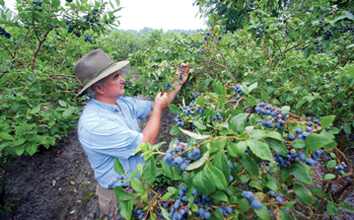If New Jersey invites you for dinner, be prepared to dine at a table seating 715,000 acres, with a blinding assortment of fresh fruits and vegetables. Of note are some recent shifts in land use, such as more blueberry acreage and less devoted to orchards. “We’d like to plant more to blueberries,” confirms Robert Von Rohr, director of marketing at Sunny Valley International in Glassboro, “but we’ve literally run out of room.”
Despite the shift, New Jersey is still a top peach producer (fourth nationally behind California, South Carolina, and Georgia), with blueberries holding at fifth place (behind Georgia, Michigan, Oregon, and Washington) in 2014. Cranberries are also a top commodity, with New Jersey ranking third in the nation behind Massachusetts and Wisconsin in production.
And while New Jersey has often been defined by its proximity to New York City and the many businesses in and around Newark, buyers and consumers alike are rethinking what the state is all about. “A lot of people associate New Jersey with the northern half of the state—the metropolitan half,” explains Bill Nardelli Sr., of Nardelli Brothers, Inc. in Cedarville. “More and more, people are finding out there’s a reason we’re called the Garden State.”
Planting and Growing Advantages
Ryan Flaim, managing member of R&R Flaim Next Generation Produce in Vineland, explains why this highly urbanized state is also profoundly abundant
in fruits and vegetables. “We have earlier product than other states, except for California,” he asserts, referring to some plantings as early as April and harvests beginning in May and June. Further, the southern portion of the state has optimal growing conditions. “This is due to our sandy soils and moderate climate,” Flaim says.
Average sales per grower have also continued to climb over the last several years. “I would say it’s driven by the locally-grown movement of blueberries and peaches,” posits Von Rohr, while Flaim has seen a surge in demand for Asian vegetables, radishes, romaine lettuce, and the increasingly popular kale.
This has also proven true for John Molinelli, Inc. in Vineland and the company’s Ashtyn Leigh Farms, which grows a wide variety of greens including kale, collards, and methi leaf (also known as fenugreek, often used as an herb or spice in a variety of dishes).
Branding and Recognition
Two additional factors in the marketing success of New Jersey’s produce continue to be easy access to several major metropolitan areas, and the state’s branding programs. Both “Jersey Fresh” and “Jersey Grown” drive an enduring preference for homegrown produce with wholesalers, retailers, and consumers, and these labels are recognized far beyond the borders of the state.



